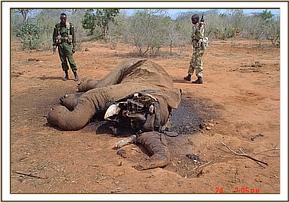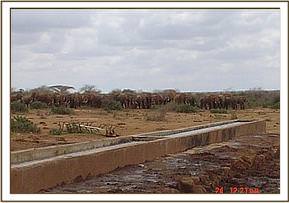The activities for the month of August started with the translocation of seven adult Rothschild giraffes (6 females and one male) from Bamburi’s Baobab farm (Haller Park) to Nguuni Nature Sanctuary, 5km away
The activities for the month of August started with the translocation of seven adult Rothschild giraffes (6 females and one male) from Bamburi’s Baobab farm (Haller Park) to Nguuni Nature Sanctuary, 5km away. The objective for the translocation was to de-stock Baobab farm from 11 to 4 giraffes because of inadequate browse which had resulted to poor body condition in most of the animals and mortalities in young calves due to malnutrition. This has led to a very low recruitment rate. Nguuni has adequate browse composed mainly of Acacia nilotica species. Lewa Wildlife Conservancy which has a fully fledged capture team had been contracted to do this work. The mobile vet unit was requested to provide assistance on veterinary aspects. The exercise commenced on the 6th when three females were moved. The male and a female were moved on the 7th and the last two females were moved on the 8th.
Capture was done within about a 2 ha enclosure erected of Hessian material. Animals normally regard the plastic sheeting as a solid wall and seldom attempt to escape through it. It prevented animals escaping into other areas of the farm where cliffs from limestone quarrying are prevalent. The enclosed area was relatively flat and ideal for recovery of immobilised animals. The animals were enclosed and fed for three days before the capture exercise began.
The capture exercise entailed individual immobilisation with Etorphine Hcl (M99®) combined with Xylazine Hcl (Chanazine®) at 13- 15mg and 25-30mg respectively (the lower doses for smaller animals and higher ones for the bigger animals). Administration of these drugs was achieved by remote injection with the Dan-Inject CO2 propelled dart rifle. The giraffes were habituated and darting was done on foot. Only the darter and a spotter to assist with the identification of animals earmarked for translocation were allowed inside the enclosure during darting to avoid unnecessary disturbance. The rest of the capture personnel were called in once signs of narcotisation were observed.
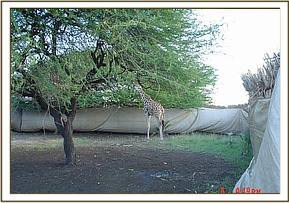
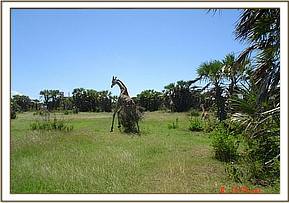
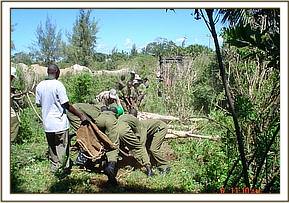

Once the animal was sufficiently sedated, the capture team would rope it down, blind fold it, and the antidotes injected into the jugular vein. Etorphine was reversed with Diprenorphine Hcl (M5050®) at 3x the dose of Etorphine used, while xylazine was reversed with 5mg Atipamezole (Antisedan®). Both drugs were given in the same syringe and the respiration monitored to determine the response to the antidotes. It was judged adequate if deep and regular, and the mucus membranes moist and pink. The response in all animals was satisfactory and no additional antidotes were given. Twelve-mg of M5050® were also given intramuscularly to take care of any re-narcotisation that may occur. The condition occurs when M99® is re-cycled either from the enterohepatic circulation or redistribution from adipose depots. Each animal was also given a broad spectrum amoxycillin based antibiotic (Betamox®) intramuscularly and Ivermectin (Ivomec®) to treat internal and external parasitism. Meanwhile, it was processed for loading into the recovery trailer and after loading it was transported in the same to the release site. It was transported blind folded to reduce stress from visual stimulation. The animals were released into a holding facility for a few hours for observation of any complications that may have arisen during capture and transportation before being free released. The exercise was very successful and no mortalities were experienced. Very high mortalities during giraffe capture have been documented.
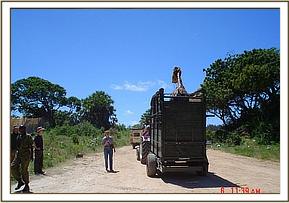
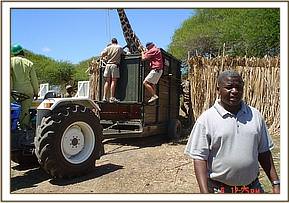
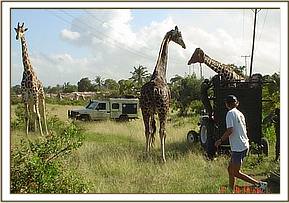

On the afternoon of 14th, the proprietor of King Fisher tented camp near Sala Gate within Tsavo East sighted an elephant calf wandering alone 15km from Sala gate along the Galana River. After ascertaining that there were no other elephants in the area and it was either orphaned or separated from its mother and/or family, he promptly called the unit for rescue. Together with the de-snaring team we responded immediately. The calf was found in the same general area with no other elephants on sight. The age was estimated to be about 15 months but initial report indicated that it was only a few months old. We proceeded with the rescue exercise. It was restrained physically, the legs properly secured, loaded into the vet truck and transported to the Voi orphanage for an overnight stay. It was airlifted to the Nairobi nursery the next day. Reports so far indicate that the calf is doing very well and has already acclimatised.
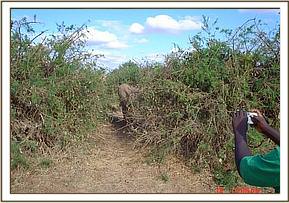
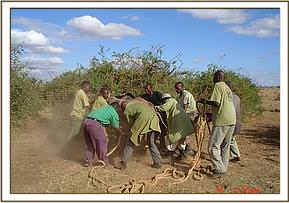
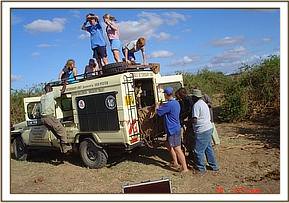

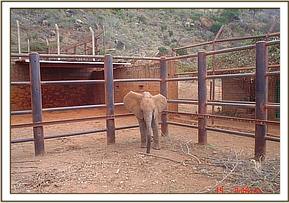

Amboseli national park reported an elephant with two spears still embedded on its head on the 17th. The elephant identified as Odile, the matriarch from the OB family, was on sight and required immediate attention before it retreated back into the swamps. They arranged for me to be airlifted immediately by an aircraft belonging to the Amboseli Elephant Research Project. However, it couldn’t be possible for me to be brought back thus the vehicle had to follow. The elephant was found to have moved deep into Solanum incum (Sodom’s apple) bush near Oldare area by the time we arrived. It took nearly three hours of manoeuvring and aerial support to get to it. The first dart composed of 17mg Etorphine Hcl landed perfectly on the left thigh but the animal did not show any signs of narcotisation. After 25 minutes and still no sign at all, it was given another full dose. On dart impact, it fled into an even thicker bush. The terrain was extremely difficult to effectively herd it to go down in an open area. It went down after about 10 minutes but accessibility proved extremely difficult and it took almost 7 minutes to get to it. The spears, one at the temple and the other at the base of the trunk, were deeply embedded and required several men to pull out.
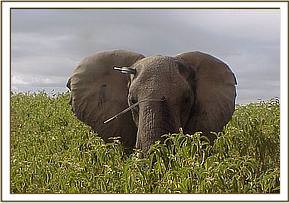
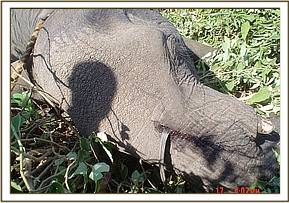
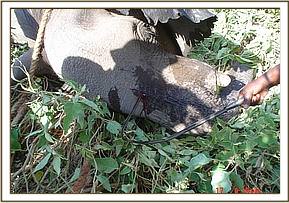

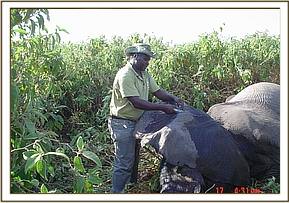

Odile had a family of 14 individuals. It was speared while defending its family against Maasai morrans on a revenge mission on claims that one of their cows had been killed by elephants while watering their animals within the park. It became separated from its family after the incident. Before we left for Tsavo the following day, an aerial survey was done to try and locate the family. Ground searching by vehicle was resorted to facilitate more detailed observation of families seen during the aerial survey. Fortunately, the family was found near the Research camp. One of the cows was observed to have an infected spear wound on its right shoulder but the rest were unharmed. The wound was discharging pus and the animal seemed to be in some pain as it occasionally avoided bearing its full weight on this leg. It also kept on scratching the wound. We decided to treat it in order to arrest the infection before it spread. It was immobilised with 17mg M99® and went down in about 7 minutes on its sternum. We quickly rolled it over onto lateral recumbency to prevent respiratory complications that arise on sternal recumbency. The pus was cleaned out and the wound treated in the same way like the above elephant.
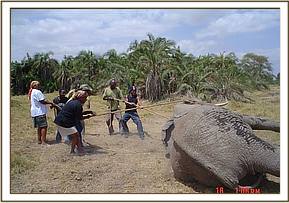
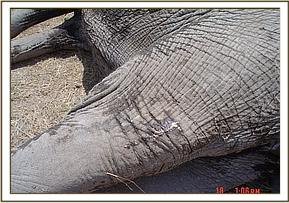
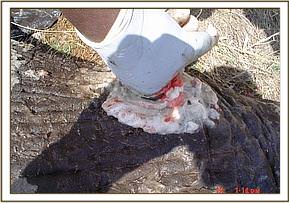

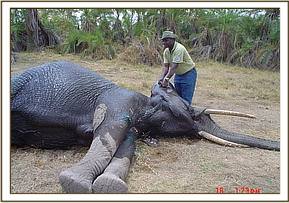

Just before embarking to treat the above elephant, we received a radio message from Voi that Nepasha, an orphan at the Ithumba orphanage, had a piece of stick piercing its left fore leg. The leg had become swollen and painful. We left Amboseli for Voi in the afternoon and proceeded to Ithumba the following day (the 19th). The calf would not allow anybody to touch that leg and physical restraint to facilitate treatment proved futile. The stick was deeply embedded and had no grip to allow its removal without proper restraint. The calf was therefore given 3mg Etorphine Hcl by hand injection to cause mild narcotisation to allow physical restraint and administer treatment. The stick measuring about 2 inches in length was subsequently removed.
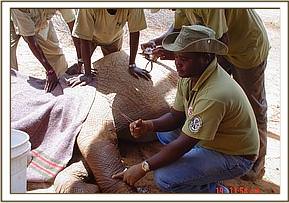
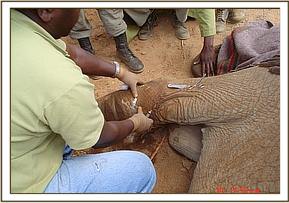

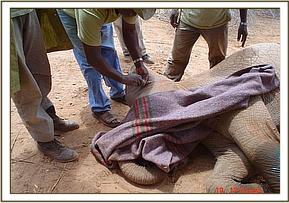
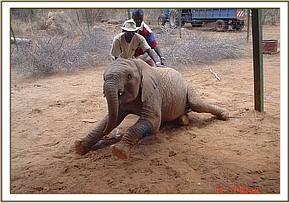

On the 24th August, the unit was requested by the management of Tsavo East Park to help assess the possible cause of death in an adult elephant at Dakota ranch on the southern boundary of the park. The carcass was however in an advanced stage of decomposition (at least one week old) to do any autopsy. However, foul play is suspected as the tusks were missing.
